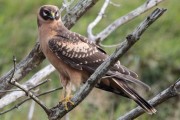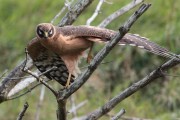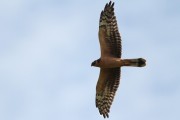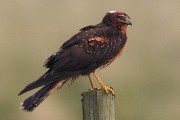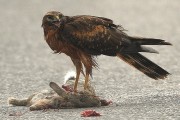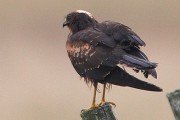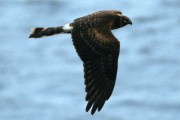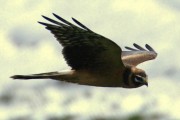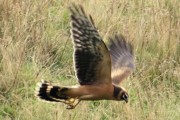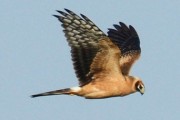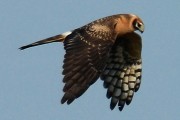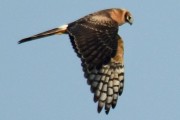Pallid Harriers in Shetland in 2011
Posted by Brydon Thomason on Saturday 17th December 2011 | Birding in Shetland
The year’s unprecedented invasion will undoubtedly stand as one of the most monumental highlights of the birding year. Fortunately three of us were individually in on the ‘finding’ action but just how many were there? Here Bird Report editor Mike Pennington trawls through the report database to summarise the Shetland part of the story of this year’s record-breaking Pallid Harrier influx.
In September 2001, a juvenile Pallid Harrier spent a week coming in to roost at the Brig of Bakkasetter (‘Brow marsh’) in Dunrossness. It was just the 11th for Britain, so it was a well-twitched bird. It was also just the third for Shetland: the previous records involved a bird, eventually shot, on Fair Isle in April and May 1931, and an elusive two-day bird around Exnaboe in September 1993.
Perhaps surprisingly, the species was recorded in four of the next five years and it had established itself as an almost expected early autumn vagrant, even though this flurry of records was followed by three blank years in 2008-10. Favourable weather conditions, with south-easterlies in August 2011, therefore, had many birders hoping for an appearance, perhaps even a chance to add the species to their find-lists, but no-one was prepared for the deluge of records that followed.
The first to arrive was a ‘probable’ photographed very distantly on Foula on 11th August. A juvenile on Fair Isle the following day, 12th-15th August could conceivably have been the same individual. Then a juvenile was seen on Noss on 24th August and on Bressay on 26th. A third juvenile turned up on Unst on 25th August, remaining on the island until 14th September.
Unst; These stunning images of one of the first birds to arrive are far and way the most evocative images of Pallid harrier taken in Shetland. Photos: Robbie Brookes.
A ringtail harrier believed to have been a Pallid was seen in poor weather on Out Skerries on 28th, quite possibly the Noss bird. Then what seems to have been a new juvenile was seen at Sandgarth, near Voe and later the same day at Sand Water in central Mainland on 31st August. This bird was quite a distinctive individual, with an unusually indistinct ‘boa’ (the diagnostic neck collar pattern of Pallids), hence the fact that it was believed to be a new bird (unless photos or descriptions of the Noss bird suggest similarities to connect the records). A ‘probable’, presumably the same bird, was reported at Stromfirth just two days later on 2nd September.
Spiggie / Hillwell; Although its plumage was heavily contaminated, presumably by Fulmar oil, this was a very popular and often obliging bird throughout its long stay. Photos: Jim Wood.
Next to be located was another distinctive bird, a juvenile with its plumage contaminated by Fulmar oil, which was first seen around Spiggie on 3rd September. This bird was usually seen around Spiggie and Hillwell, but wandered widely, being seen as far away as Sandwick. This bird was also distinctive, as it showed some features that could have suggested that it was a Pallid x Hen Harrier hybrid (see http://birdingfrontiers.com/2011/10/19/identification-update-pallid-harrier/), although current opinion is that it is a Pallid, albeit a less than typical bird. Being easily recognisable this bird’s movements illustrated just how far an individual could range, even with contaminated plumage.
Another juvenile in south Mainland from at least 10th September (on which day it was tracked from Virkie to Hillwell) was unoiled and therefore different to the oiled bird in the same area. The Fulmar-oiled bird was last seen on 17th October, and there was an unoiled bird until 6th October; there are claims of more than one unoiled bird in the south Mainland, but these appear to be unsubstantiated so far.
Two more new birds then appeared: a new juvenile was on Fair Isle on 11th-14th September and another juvenile visited three sites in south Yell on 12th-16th September. This meant that on 12th-14th September there were five birds in the islands: Unst, Yell, Fair Isle and 2 in south Mainland. The earlier Fair Isle bird presumably moved south and the distinctive Sandgarth/Sand Water bird was apparently also different, giving a minimum of seven individuals. But the Noss bird could have been one or other of the two south Mainland birds (even the oiled bird could have become oiled after leaving Noss) or even Fair Isle.
Yell; With images of all three birds recorded in the north isles it was reasonably easy to retrospectively separate individuals from each other. Hopefully images not yet submitted of other sightings on Mainland may help distinguish any further relocation/duplication as with the Fetlar bird.
Photos: Dougie Preston
Fairly clear so far, but then on 17th September there was one between Voe and Aith (not very far from Sandgarth/Sand Water and so conceivably the same bird). Another sighting on the same day on Bressay, followed by one at Gulberwick on 18th were both possible Pallids.
After almost two weeks with no new claims, a bird on Fetlar from 30th September to 5th October would appear to be good candidate to be a new bird. But hold on – photos showed this bird to have an indistinct boa and so it was very similar to the Sandgarth/Sand Water, last seen for certain four weeks earlier. But if it was the same, where had it been hiding for the best part of a month (unless it was the Voe/Aith bird or some of the other probables/possibles).
Fetlar; This bird turned out to be a very interesting individual in that it appeared to offer a very useful insight into the influx and illustrate the probability of birds lingering and in turn reappearing at new locations. Photos: Brydon Thomason.
Further October records all just muddy the waters, at least until such time as photos and descriptions are available. A bird was reported at Baltasound on 3rd, more than two weeks after the last report on Unst. Singles at Channerwick on 4th-6th October, then Trondra on 7th and Wester Quarff on 13th were presumably further records of the unoiled bird from south Mainland wandering further afield and drifting north. One reported at Bardister in north Mainland on 9th was even further from any previous sighting. Was this a new bird? Who knows?
By October, however, observers were tending to be a bit ‘Pallid-happy’. Pallids were suddenly ‘not that big a deal’, they had been seen virtually daily in Shetland for two months, so they were definitely being reported without considering whether they were new birds. In addition, there were several orange-tinged Hen Harriers around (singles on Unst, Fetlar and in South Mainland, at least) and it is known that these birds were sometimes being reported wrongly as Pallids.
Overall, it seems that there were definitely a minimum of seven birds, as described above, but whether any new birds arrived after mid-September is unclear. The upper limit for the autumn will depend on what gets submitted and what the photos and descriptions tell us.
Mike Pennington


